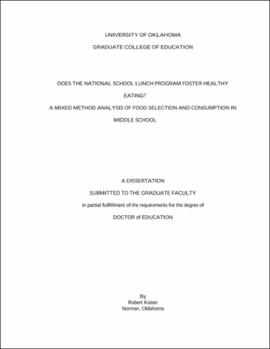| dc.contributor.advisor | Hamlin, Daniel | |
| dc.contributor.author | Kaiser, Robert | |
| dc.date.accessioned | 2022-05-05T20:05:37Z | |
| dc.date.available | 2022-05-05T20:05:37Z | |
| dc.date.issued | 2022-05-13 | |
| dc.identifier.uri | https://hdl.handle.net/11244/335543 | |
| dc.description.abstract | American children exhibit the highest rates of obesity among industrialized nations. To promote healthy eating, policy makers have revised standards for the National School Lunch Program (NSLP), which provides free and discounted lunches to nearly 30 million low-income children during the school year. Previous studies report mixed results on the physical health of students participating in the NSLP, but little research examines what students consume when provided a school lunch through the program. In this mixed-methods study, a real-time analysis of the nutritional content of food both selected and consumed during school lunch was performed by taking a random sample of students’ lunches (n = 141) over a 3-week period in an urban Title I middle school. Statistical results indicate that selected school lunches are low in nutritional density and high in sugar while food that students ultimately consumed was lower in nutritional value than selected lunches. Following these analyses, 20 interviews with middle school students attending Title 1 middle schools were conducted to develop an understanding of the patterns underlying the statistical results. Grounded in the Social Cognitive Theory (STC), qualitative interviews offered evidence that students pay attention to the appearance and taste of the various food offerings in the cafeteria. Students also seemingly understand what a healthy lunch consists of, but seem to be primarily selecting the lower nutrient-dense foods. Student home selections also do not seem to mirror those of their cafeteria selections. The qualitative findings suggest that cafeterias may be unknowingly contributing to student eating patterns by their presentation of certain foods, the lack of variety offered, along with the lack of autonomy when it comes to students seasoning their own foods. More research is needed to better understand how these variables may contribute to student health outcomes, yet this study begins to better explore how the production of food within school cafeterias may encourage or discourage consumption. This study contributes to the literature by using an analytical procedure that provides precise estimates of student consumption patterns during school lunch. It also offers in-depth analysis of the factors behind students’ meal selection and consumption choices. Future research is needed to understand how effective the NSLP is in its ability to increase nutrient dense food consumption. | en_US |
| dc.language | en | en_US |
| dc.subject | Education | en_US |
| dc.subject | School Lunch | en_US |
| dc.subject | Policy | en_US |
| dc.title | Does the National School Lunch Program foster healthy eating? a mixed method analysis of food selection and consumption in middle school | en_US |
| dc.contributor.committeeMember | Edwards, Beverly | |
| dc.contributor.committeeMember | Ford, Timothy | |
| dc.contributor.committeeMember | Meyers-Morgan, Meg | |
| dc.date.manuscript | 2022-03-24 | |
| dc.thesis.degree | Ed.D. | en_US |
| ou.group | Jeannine Rainbolt College of Education::Department of Educational Leadership and Policy Studies | en_US |
